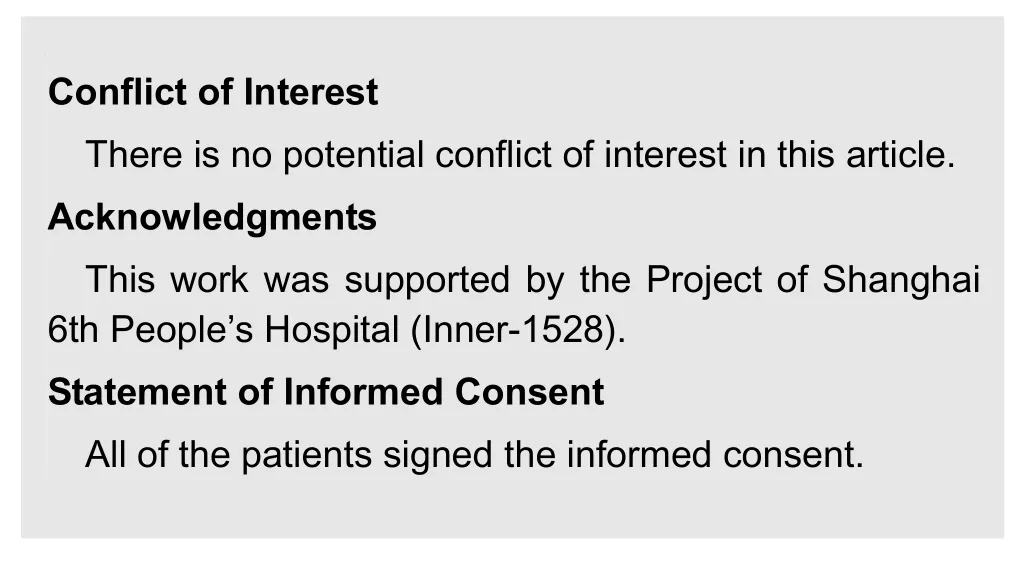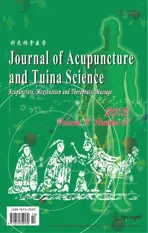Therapeutic Efficacy Observation on Point-toward-point Acupuncture Combined with Herbs Iontophoresis for Knee Osteoarthritis
2013-07-18LiShishengWuYaochiZhangJunfengZhouJinghui
Li Shi-sheng, Wu Yao-chi, Zhang Jun-feng, Zhou Jing-hui
No.6 People’s Hospital Affiliated to Shanghai Jiaotong University, Shanghai 200233, China
Therapeutic Efficacy Observation on Point-toward-point Acupuncture Combined with Herbs Iontophoresis for Knee Osteoarthritis
Li Shi-sheng, Wu Yao-chi, Zhang Jun-feng, Zhou Jing-hui
No.6 People’s Hospital Affiliated to Shanghai Jiaotong University, Shanghai 200233, China
Objective: To observe the clinical efficacy of point-toward-point acupuncture combined with herbs iontophoresis in treating knee osteoarthritis.
Methods: A total of 100 patients were randomly divided into a treatment group and a control group, 50 cases in each. Patients in the treatment group received point-toward-point acupuncture with long needle combined with herbs iontophoresis treatment; while those in the control group were only treated by point-toward-point acupuncture with long needle. Clinical efficacies of the two groups were compared after treatment.
Results: The total effective rate was 92.0% in the treatment group, versus 82.0% in the control group, and the difference was statistically significant (P<0.05).
Conclusion: The point-toward-point acupuncture with long needle combined with herbs iontophoresis treatment for knee osteoarthritis has a significant effect.
Iontophoresis; Acupuncture Therapy; Point-toward-point Method; Acupuncture Medication Combined; Osteoarthritis, Knee
Osteoarthritis (OA) is a chronic joint disease with a high incidence. It is characterized by degeneration and destruction of articular cartilage as well as bone hyperplasia, joint pain and dysfunction, and thus can seriously affect the patient's quality of life[1], knee osteoarthritis (KOA) is one of the most common joint conditions. The main pathological changes of KOA are knee joint and soft tissue degeneration and subsequent pain, effusion, swelling, limited range of motion and a sense of friction of the joint. National statistics materials show that X-ray examinations indicate that KOA manifestations present in nearly 50% of China’s population aged 60 and above, and in 80% of the people aged 75 years and above[2]. We treated 50 patients with KOA from April 2011 to September 2012 using point-toward-point acupuncture with long needle combined with herbs iontophoresis, compared with 50 patients treated with point-toward-point acupuncture with long needle alone, and the report is given as follows.
1 Clinical Materials
1.1 Diagnostic criteria
TheAmerican College of Rheumatology Criteria for the Diagnosis ofKnee Osteoarthritis[3]were used to diagnose KOA (using history and clinical examination).
Pain in the knee and three of the following: Age >50 years; morning stiffness <30 min; crepitus on active motions; bony tenderness; bony enlargement; no palpable warmth of synovium.
1.2 Inclusion criteria
Patients met the diagnostic criteria; their ages were between 50 and 75 years old; they had no history of taking related medication or having relevant treatment in nearly one week; they voluntarily accepted three courses of treatment and signed informed consent forms.
1.3 Exclusion criteria
Patients with acute joint injury, the knee bone and joint tuberculosis, cancer, rheumatism and rheumatoid osteoarthritis; patients with complications such as serious cardiovascular, cerebrovascular, liver, kidney, or hematopoietic system diseases; patients with mental illness; pregnant or lactating women; patients at late stage of knee deformity needing surgical treatment; patients who were unwilling to accept the treatment or sign informed consent forms.
1.4 General data
One hundred KOA patients were enrolled and randomly divided into a treatment group and a control group according to visiting sequences, and there were 50 cases in each group. There were no significant differences in gender, age, duration and other general data between the two groups (P>0.05), indicating that they were comparable (table 1).

Table 1. General data comparison of the two groups
2 Therapeutic Methods
2.1 Treatment group
2.1.1 Point-toward-point acupuncture
Acupoints: Xuehai (SP 10), Liangqiu (ST 34), Dubi (ST 35), Neixiyan (EX-LE 4), Yinlingquan (SP 9), Yanglingquan (GB 34), Xuanzhong (GB 39), Sanyinjiao (SP 6).
Operation: Asked the patient to take a supine position, placed a blindfold on the patients’ chest to block their sight (to avoid them knowing the specific treatment), and let their affected limb buckle (put a piece of triangle sponge in popliteal space). Using stainless steel filiform needles of 0.35 mm in diameter and 75 mm in length, punctured Xuehai (SP 10) toward Liangqiu (ST 34), Dubi (ST 35) toward Neixiyan (EX-LE 4), Yinlingquan (SP 9) toward Yanglingquan (GB 34), and Xuanzhong (GB 39) toward Sanyinjiao (SP 6) with fingers-squeezed-needle inserting method. The inserting depth of the tip should reach the skin without penetrating it. Each manipulation took 20 min. 2.1.2 Iontophoresis
Ingredients:Chuan Xiong(Rhizoma Chuanxiong) 150 g,Chi Shao(Radix Paeoniae Rubra) 150 g,Sheng Di Huang(Radix Rehmanniae Recens) 150 g,Dang Gui(Radix Angelicae Sinensis) 150 g,Hong Hua(Flos Carthami) 50 g, andZhi Cao Wu(Radix Aconiti Kusnezoffii) 100 g.
Operation: Decocted the herbs and pour proper amount of liquid in electrode plate of HL-III type low-frequency electronic treatment apparatus, squeeze out excess liquid, put the electrode plate in the area around the affected knee joint, and selected automatic treatment program for elbow or knee joint pain at 50-1 000 Hz and automatic frequency, and kept the intensity of stimulation within the patient’s tolerance. Each treatment took 20 min.
These treatments were operated every other day, 10 times as a course of treatment, and there was a one-week break between two treatment courses. Efficacy was observed after 3 courses.
2.2 Control group
The patients were treated with the same pointtoward-point acupuncture as the treatment group including acupoints, operation and treatment course.
3 Therapeutic Efficacy Observation
3.1 Observation indications
3.1.1 Evaluation of knee pain
Visual analogous scale (VAS) was used to evaluate knee pain degree, which means to use a scale of 10 cm in length for measurement. One end was marked with‘0’ representing painless, while the other was marked with ‘10’ representing the most intense pain. Patients marked the knee pain degrees on the scale following one same doctor’s instruction after 5-minute weightbearing standing before treatment as well as after 3 treatment courses.
3.1.2 Assessment of knee function
It refers to knee osteoarthritis disease classification criteria of Western Ontario and McMaster Universities arthritis index (WOMAC index) and Lequesne index of severity for osteoarthritis of the knee to comprehensively assess the knee functions (knee stiffness, range of motion, and maximum walking distance).
3.2 Therapeutic effect criteria
They accord to the therapeutic effect criteria of KOA in theCriteria of Diagnosis and Therapeutic Effects of Diseases and Syndromes in Traditional Chinese Medicine[4].
Cure: Pain and swelling of the joint disappear; motion function returns to normal; laboratory examination is normal.
Improved: Pain and swelling of the joint relieve; motion function improves.
Invalid: There is no relief of the pain or swelling of the joint.
3.3 Statistical methods
Data were analyzed by SPSS 19.0 statistical software. Measurement data were expressed as mean ± standard deviation (), pairedt-test was for the comparison of VAS scores before and after treatment between the two groups; Rank sum test was used for two groups’comparison of clinical efficacy.P<0.05 indicated that the difference was statistically significant.
3.4 Treatment results
Two groups’ VAS scores before treatment showed no significant difference (P>0.05). After treatment, the VAS scores of the two groups significantly decreased (bothP<0.05), and the improvement of the treatment group was more significant than that of the control group (P<0.05), (table 2).
Table 2. Comparison of VAS scores before and after treatment between the two groups (, point)

Table 2. Comparison of VAS scores before and after treatment between the two groups (, point)
Note: Intra-group comparison with score of before treatment, 1)P<0.05; compared with the control group after treatment, 2)P<0.05
GroupsnBefore treatment After treatment Treatment 50 7.52±0.42 2.17±0.361)2)Control 50 7.47±0.39 2.68±0.341)
Based on rank sum test, the therapeutic efficacy difference was statistically significant (P<0.05), indicating that the treatment group had a better efficacy than the control group (table 3).

Table 3. Comparison of clinical therapeutic efficacy between the two groups (case)
4 Discussion
KOA belongs to the catalogue of ‘knee pain’,‘Bi-Impediment syndrome’ and ‘bone Bi-Impediment’in traditional Chinese medicine. It occurs as a result of wind, cold and dampness attacking meridians and staying in the knee joint, causing blood stagnation. Because of the theory that ‘stagnation causes pain’, there are symptoms such as periarticular pain, numbness, heavy feeling, swelling, burning and heat sensation, and difficulty in extension and flexion of the knee.
Acupuncture is a well-recognized effective alternative or complementary therapy for KOA[5-9]. Long needle point-toward-point acupuncture has a lot of advantages such as simple operation, strong needling sensation and remarkable effects. In this study, patients’ points around the affected knee were acupunctured by this method so as to promote the body in releasing analgesic substances like endogenous opioid, to increase pain threshold and finally alleviate pain. This method can also improve local blood circulation, circulate meridian-qi, thus it is beneficial to the absorption of exudate and articular cartilage repair[10-11].
Herbs iontophoresis device is a new generation of medical devices based on the theory of bioelectric medicine conductivity, heat medicine, magnetic science, traditional Chinese medicine and modern microcomputer technology, combined with years of clinical practice, research and development, influencing the affected lesions by its functions such as anti-inflammation, dispersing swelling, killing pain, loosening adhesions, regulating and improving local circulation as well as relaxing muscles and tendons and removing obstruction[12]. Therefore, it can alleviate and eliminate numbness and stabbing pain of sympathetic nerves and nerve root as well as other symptoms caused by KOA.
This study showed that point-toward-point acupuncture with long needle combined with local herbs iontophoresis treatment for KOA had good efficacy without pain and many other advantages, thus it can be widely used as a treatment protocol for KOA.

[1] Wang JH. Multivariate therapy treatment for 186 cases with knee osteoarthritis. Zhongyi Waizhi Zazhi, 2011, 20 (6): 16-17.
[2] Xu ST, Ge BF, Xu YK. Practical Orthopedics. 3rd Edition. Beijing: People's Military Medical Press, 2006: 1337.
[3] Chen BC. Osteoarthritis. Beijing: People’s Medical Publishing House, 2004: 354-367.
[4] State Administration of Traditional Chinese Medicine. Criteria of Diagnosis and Therapeutic Effects of Diseases and Syndromes in Traditional Chinese Medicine. Nanjing: Nanjing University Press, 1994: 30.
[5] Nejrup K, Olivarius Nde F, Jacobsen JL, Siersma V. Randomised controlled trial of extraarticular gold bead implantation for treatment of knee osteoarthritis: a pilot study. Clin Rheumatol, 2008, 27(11): 1363-1369.
[6] Zhang GB, Wang WL, Zhang Q, Bao CL, Zhao WF, Dong GR. Comparative study between fire needling and warm needling therapies for knee osteoarthritis. Shanghai Zhenjiu Zazhi, 2013, 32(4): 299-301
[7] Ku XJ, Jiang SY, Chu LX. Clinical efficacy evaluation on electroacupuncture for osteoarthritis and observation on biomechanical indexes. J Acupunct Tuina Sci, 2009, 7(5): 261-264.
[8] Chen Q, Yao XP. Therapeutic observation on threeknee-point needling plus intra-articular injection of Sodium Hyaluronate for knee osteoarthritis. Shanghai Zhenjiu Zazhi, 2013, 31(3): 203-204.
[9] Huang RD, Gong L, Wu LX, Wu JY. Clinical research of rolling manipulation in treating knee osteoarthritis. J Acupunct Tuina Sci, 2008, 6(6): 356-359.
[10] Zhang ZC. Observation on the efficacy of point-throughpoint acupuncture plus ginger moxibustion in treating genual osteoaritis. Shanghai Zhenjiu Zazhi, 2009, 28(6): 348-349.
[11] Wang CM, Li SS. Clinical study on treatment of knee osteoarthritis with combined acupuncture and medication. J Acupunct Tuina Sci, 2009, 7(6): 354- 356.
[12] Li XL, Chen XY, Jin NL, Wang B, Cao KZ, Li GA. Comparison of the efficacy of acupuncture with He-Ne laser light in treating knee osteoarthritis. Shanghai Zhenjiu Zazhi, 2012, 31(11): 829-830.
Translator: Deng Ying
R246.2
A
Date: June 6, 2013
Author: Li Shi-sheng, resident
Wu Yao-chi, chief physician, doctoral supervisor.
E-mail: wuyaochi11238@hotmail.com
杂志排行
Journal of Acupuncture and Tuina Science的其它文章
- Therapeutic Efficacy Observation on Combining Acupuncture and Chinese Herbal Fumigation for Cervical Radiculopathy
- Clinical Study on Moxibustion at Shenque (CV 8) for Chronic Urticaria
- Clinical Research Progress of Acupuncture-moxibustion for Chronic Urticaria
- Clinical Observation on Dong’s Extraordinary Points for Tinnitus Due to Cervical Spondylosis
- Observation on Clinical Effect of Superficial Needling for Intractable Humeral Epicondylitis
- Clinical Observation on Acupuncture Plus Acupoint Sticking for Bronchial Asthma in Remissive State
